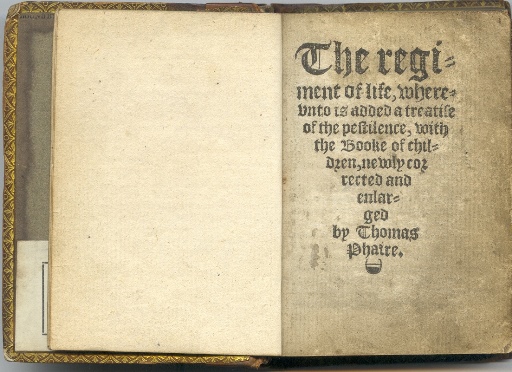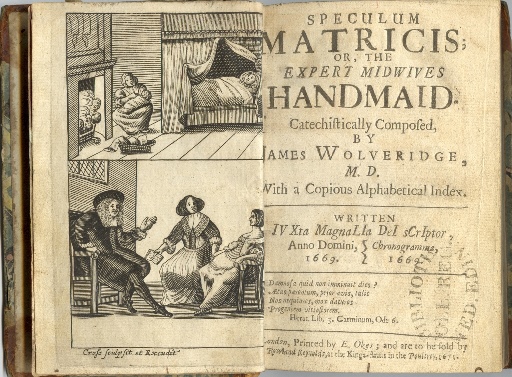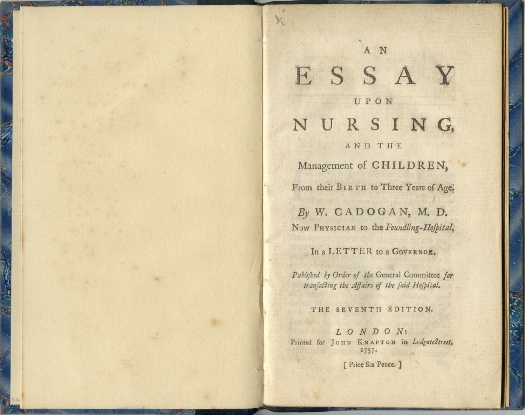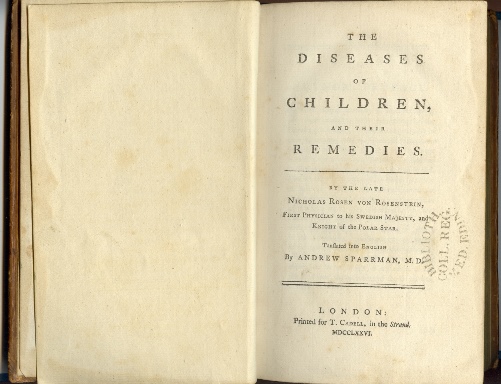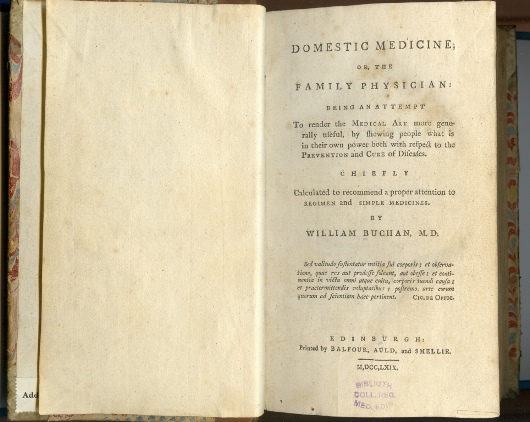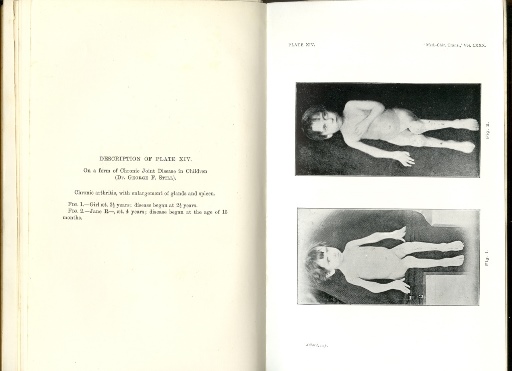Thomas Phayer (ca.1510-1560)
The boke of chyldren
London, 1553
Thomas Phayer was a physician, lawyer and poet. The boke of chyldren was first published in 1545, and was the first original work on the diseases of children to be written in English. It was included as the second part of Phayer’s translation of The regiment of life. Phayer outlined his aims in the preface. "My purpose is here to doo theym good that have moste nede, that is to saye, children.” Referring to other medical writers he asks “How long wold they have the people ignorant? Why grutche they phisyke to come forth in Englyshe? Woulde they have no man to know but onely they?” His little book covers forty common children’s diseases and their remedies.
James Wolveridge (17th century)
Speculum matricis
London, 1671
James Wolveridge practised medicine at Cork in Ireland. He has often been accused of plagiarism as most of his book is clearly taken from earlier works. Wolveridge, however, was quite open about this, and wrote that he was attempting to give basic instruction in midwifery and child care taken from the best writers on the subject. In all his readings of authors, he tells us, he had “not seen any that had written in so plain and perspicuous a method … sufficient to direct and inform midwives in their office”. The College copy is the only known complete copy of this book in the world.
Walter Harris (1647-1732)
A treatise of the acute diseases of infants
London, 1742
Walter Harris was physician to King William and Queen Mary. His treatise on the acute diseases of infants was first published in Latin in 1689. It was subsequently translated into English, German and Dutch, and became the standard work on paediatrics for nearly a hundred years.
William Cadogan (1711-1797)
An essay upon nursing, and the management of children
London, 1757
The above work originally took the form of a letter written by Cadogan in 1748 to one of the governors of the Foundling Hospital in London. It was subsequently “published by order of the General Committee for transacting the affairs of the said hospital”. Cadogan warned against many practices of infant care which had become prevalent. The tight swaddling of infants, for example, extended back to Biblical times, and binding of the waist was also commonplace. Wet nurses were used by rich and poor alike; the rich to free the mother for social pursuits, the poor to free her to return to work. Cadogan strongly condemned such practices. He advocated maternal breastfeeding, and looser clothing for infants to allow their bodies to grow and develop naturally. Cadogan’s methods resulted in him being elected a governor and later Physician to the Hospital.
Nils Rosen von Rosenstein (1706-1773)
The diseases of children, and their remedies
London, 1776
Rosen has been called "The Father of Paediatrics”, and the above work is generally regarded to be the first modern textbook on the subject. A growing concern for the high infant mortality rate in Sweden led to it being one of the first countries to gather demographic statistics. The results confirmed that the majority of children lost their lives before reaching adulthood. Rosen was convinced that many childhood illnesses were due to improper care and feeding, and emphasised the need for strict cleanliness and hygiene. He describes how if a “mother cannot suckle her child, then we must accustom the child to suck by means of a little instrument, or sucking bottle”, which “ought always to be kept clean”. “Food for children” he continued “ought to be well covered over, that no insect or any such thing can get at it". By 1851 his book had appeared in at least twenty-five editions in eight languages. The English edition was translated by the Swedish naturalist and traveller Anders Sparrman while on board the Resolution during Captain Cook's voyage round the world.
William Buchan (1729-1805)
Domestic medicine
Edinburgh, 1769
William Buchan graduated MD at Edinburgh in 1761 and was a Fellow of the Royal College of Physicians of Edinburgh. He is best known for the above work which became a worldwide best seller. Drawing on his experiences at the Foundling Hospital in Yorkshire, Buchan devoted the first part of his book to the diseases of children. He declared himself to be astonished “that so little attention should in general be paid to the preservation of infant lives! What labour and expence are daily bestowed to prop an old rotten carcass for a few years, while thousands of those, who might be useful in life, perish without being regarded”.
Andrew Wilson (1718-1792)
Aphorisms composed for a text … on the constitution and diseases of children
London, 1783
Wilson studied medicine at Edinburgh and was a Fellow of Royal College of Physicians of Edinburgh. He was the first writer in Britain to advocate special training in the diseases of children as part of the medical curriculum. “I have always thought”, he wrote in the preface to the this work, “that, on account of the importance of the subject, both to families and to the public, the nature and diseases of infants merited to be treated of in a particular class, and course of lectures, as much as any one branch of medicine”. He went on to say that having found “some inconvenience both to myself and my pupils from the want of a text” he had produced a little book of aphorisms to accompany his lectures.
George Armstrong (1719-1789)
An account of the diseases most incident to children
London, 1783
In 1769 George Armstrong founded the London Dispensary for the Infant Poor. It was the first of its kind in Europe, and was a pioneering step towards the eventual creation of children’s hospitals. The descriptions of children’s diseases in this work were based on Armstrong’s own experience, and on his observations at the dispensary. Although thirty-five thousand patients were treated in twelve years, and Armstrong met many of the expenses himself, the dispensary eventually had to close due to a lack of financial support. The present day Great Ormond Street Hospital for Sick Children is only a short distance away from the site of Armstrong’s dispensary.
Michael Underwood (1736-1820)
A treatise on the diseases of children
London, 1784
Michael Underwood’s treatise was considered the best paediatric work of the 18th century. It replaced Walter Harris’s book and was used as the standard text on the subject for the next sixty years. Underwood revised and enlarged his work through seven editions. These included a description of sclerema neonatorum (Underwood’s Disease), the first clinical descriptions of poliomyelitis and congenital heart disease in children, and an early essay on infant psychology. Underwood intended that his work was “not only for medical people, but for the direction of the intelligent parent”.
Charles West (1816-1898)
Lectures on the diseases of infancy and childhood
London, 1848
Charles West studied medicine in France and Germany where hospitals for children had long been established. While working at the Universal Dispensary in Waterloo Road, London, he published the above work on children’s diseases. It was acclaimed as the best text on paediatrics by an English-speaking author. In it he emphasised the importance of breast-feeding in the prevention of infantile diarrhoea and tuberculosis, and gave important accounts of both tuberculosis and poliomyelitis. West went on to found the Great Ormond Street Hospital, and to serve as its senior physician for twenty-three years.
Sir George Frederick Still (1868-1941)
On a form of chronic joint disease in children
(Medico-Chirurgical Transactions)
London, 1897
George Still graduated MD at Cambridge in 1896 with a thesis entitled A special form of joint disease met with in children. It gave the first description of juvenile rheumatoid arthritis or Still’s Disease. The following year his observations were published in the above periodical. Sir George went on to become the first Professor of Paediatrics at King’s College Hospital, and the principal founder and first president of the British Paediatric Association.
Follow our Twitter account @RCPEHeritage or our Facebook page or sign up to our newsletter to get notifications of new blog posts, events, videos and exhibitions.




